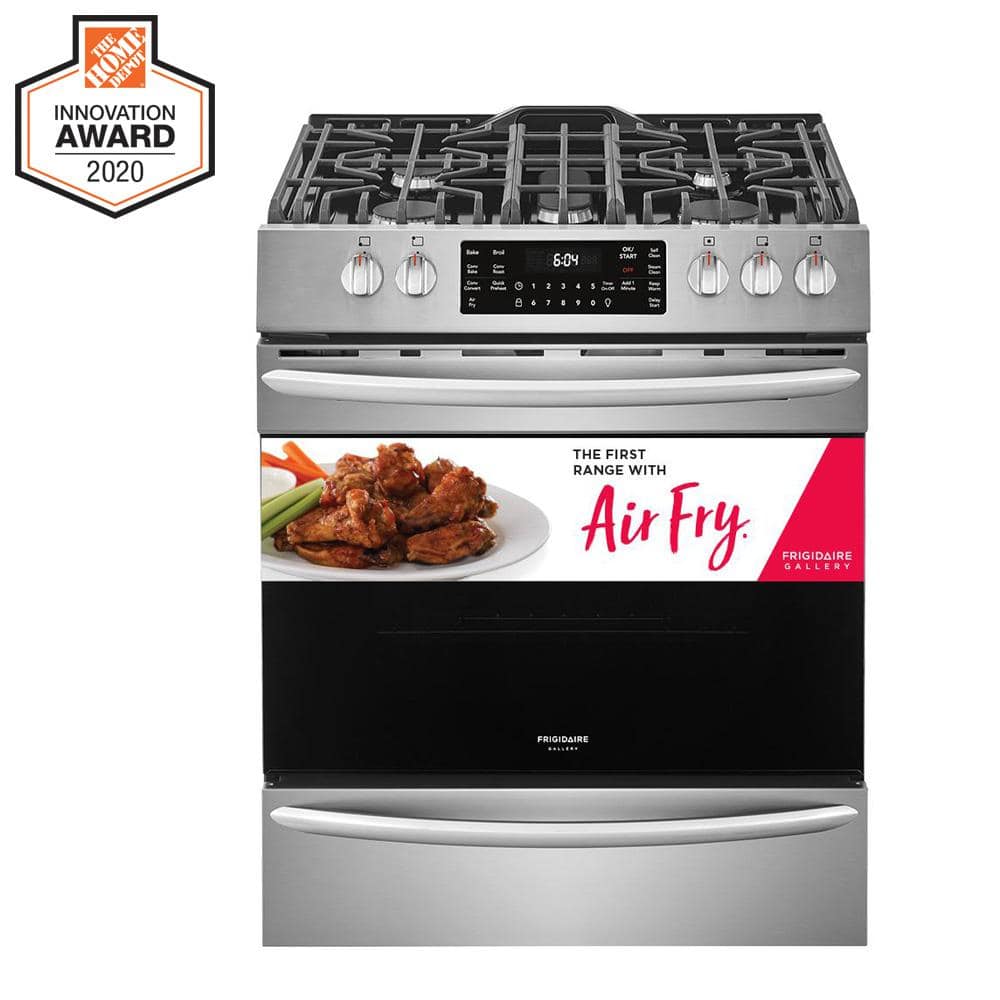LG 6.9 cu. ft. Smart Double Oven Slide In Gas Range with ProBake Convection and Wi-Fi in Stainless Steel
-
( 6 Reviews )Rated 4.83 out of 5 based on 6 customer ratings06
ProBake convection oven delivers even baking results on each rack. 5 burner stove top with UltraHeat Burner for fastest boil. Smart Home & Wi-Fi enabled to operate & troubleshoot on phone app.
No more trying to juggle and time your large meals. With 6.9 cu. ft. of capacity, you can do it all at once, all the while keeping your dishes hot and ready to serve in the warming drawer below. LG ProBake Convection gives you the confidence of professional-style baking on every rack, every time. Plus, with EasyClean, you can check a clean oven off your list after just 10 minutes and three simple steps.
- LG ProBake Convection delivers even baking results on every rack, every time. Inspired by pro-style ranges, this new LG ranged moved the heating element from the bottom of the oven to the back wall for optimal heat distribution. Enjoy consistent browning on top and bottom- with every cookie baked to perfection
- LG EasyClean brings you the fastest oven-cleaning feature yet. In three easy steps and 10 quick minutes your oven can be sparkling clean, without strong chemical fumes or high heat. Simply spray the oven interior with water, press EasyClean and then in 10 minutes, quickly wipe away any leftover grime. And you can still use the traditional self-clean cycle for the occasional deep clean
- Use the quick-heating upper oven for smaller meals on the go. For big events, you’ll have the room you need to cook all your favorite dishes, at different temperatures, at the same time. With LG, no meal (or guest list) is too big
- LG UltraHeat 18,500 BTU burners deliver every bit of the precision you love about gas with even more power. No more waiting around to bring water and other liquids to a boil
- Sleek, angled controls put power and visibility at your fingertips while bringing an updated, stylish look to your kitchen
- 5 High Performance Sealed Burners are there to meet them. These easy to clean burners provide flexible cooking power from 5,000 BTUs to 18,500 BTUs
- Intuitive SmoothTouch glass controls not only look sleek but makes operating your range a snap with just a touch of your finger. Best of all they have been designed with practicality in mind the smooth surface easily wipes clean
- LGs Detachable Wok Grate. Designed to lift a wok pan above the right front burner, the steady surface combined with the intense heat of the 18,500 BTU UltraHeat burner makes it easier to stir fry, steam, poach and sear. Crafted from cast iron porcelain for years of use
- Gliding rack brings the dish to you, extending your reach with far less effort. It offers easy access for checking on or removing your favorite dishes from the oven
- Griddle pan that fits perfectly on the oval burner on these ranges. You can start cooking right away pancakes, eggs, meat, and everything else that can be cooked on a griddle
- A premium range should meet your needs and look beautiful doing it. The Brilliant Blue Interior provides an upscale look with premium interior design
- Best view in the kitchen; this super-sized window allows you to easily check the progress of a meal no matter where its placed in the oven
Additional information
| Depth With Door(s) Open 90 Degrees (In.) | 48.88 |
|---|---|
| Lower Oven Interior Depth x Height x Width (in) | 20 x 14.25 x 24.81 |
| Upper Oven Interior Depth x Height x Width (in) | 20 x 9.25 x 24.81 |
| Product Depth x Height x Width (in) | 28.94 x 37.88 x 30 |
| Range Size | 30 in. |
| Certifications and Listings | ADA Compliant,CSA Listed |
| Manufacturer Warranty | Parts & Labor 2 Year |
Average Rating
4.83
Rated 4.83 out of 5 based on 6 customer ratings
065 Star
83.33%
4 Star
16.67%
3 Star
0%
2 Star
0%
1 Star
0%
Submit your review Cancel reply






by John
We love the fast burners and the middle burner. Cooking with tow different oven is awesome.
by Jeannie
I just purchased my stove. It has 5 burners, one with a griddle and 2 ovens! It’s easy and fun to use and beautiful to look at! It has really enhanced my kitchen and upped my cooking game. My son is developing a love of cooking and it’s a joy to watch him make us dinner with our new lovely LG stove! It’s a game-changer bringing happiness to our lives!
by Ahashley
Heats up super quickly, easy to clean and beautiful. I read reviews about the fans being too loud, they are audible but not annoying or loud by any means. I haven’t had issues with the top of the stove but it does look like it could scratch easily.
by Enelra
It’s a great range, With it being All Stainless Steel everything thing shows up, Just have to clean more often, The whole family is enjoying 🙂
by Jim
I think its a great oven so far…the only issue I have is with the control knobs. Next to near impossible to read them with the color they chose and the angle.
by Veloscotto
I installed this a month ago and it works great. The only issue I can complain about is a whistling sound using the oven. Turns out this is a known issue and I am in the process of having it addresses under the warranty. Otherwise, it works great and is nice addition to my upgraded kitchen.